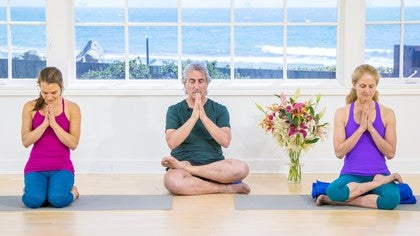Description
About This Video
Transcript
Read Full Transcript
Hi, we're here with Ilana and Betsy. And we have a breathing exercise coming up that involves what I call the hollows of the body, in this case the hollows of the torso. Hollows are everywhere on the body, on the soles, in the perineum, armpits, the back of the throat, top of the head. Hollows, or you might want to call them domes. And it's extremely important when you do a practice to keep those hollows very soft and very deep. What often happens in a typical practice is that the hollows get hard and get flattened out. And that creates a lot of tension in the body. So we're going to do a breathing exercise that works with two hollows in the body. One of them is at the top of the sternum bone here. And in the west this is called the jugular notch. But in yoga it's called the kupekanta. And that comes from the yoga sutra. And Patanjali, that means the well of the throat for obvious reasons. Patanjali says that if you meditate on this spot that you will not need to drink or eat. I suppose if you're sitting down for several hours of meditation that would be a useful thing to do. Otherwise not sure what the point would that would be. We're going to show you also two new ways to set yourself up for breathing. And we're going to start with Ilana. We're going to use the hands as tactile aids for this practice. So be ready for that. So Ilana if you just slide forward off the sticky mat for just a second please or back. Yes that's fine. And we're going to take these two blankets end-to-end. And as always we're going to make sure that the firm end is going to be underneath her shoulders. So if you would just take this one and line it up at the end of the mat there. Yes like that. Two blankets folded end-to-end thusly. When you sit you sit with your back to the firm end of the blanket. And then she'll lie back and you want to make sure that when you do this the shoulders touch the blanket. Feet on the floor knees bent feet on the floor. And then you start to push yourself slowly over the edge of the blanket. And you continue doing that until the tops of your shoulders rest down very lightly on the floor. And you take your arms out to the sides turn your palms up. And then you can stretch legs out onto the blanket. And she has asked us to put a sandbag on her thighs and let your feet go off to the sides. There you go. And as always when you use a sandbag you want to lay it right across the groins like that. Very nice. Now for Betsy we're going to do a support that's very popular with a lot of students. You need three blankets for this one and a block. We start with the first blanket folded in thirds here. Lay it on the floor. Could you pull out a little bit toward you please. Making sure the firm end is facing out. And we put the block at its head like this on one of its faces. Second blanket is the same fold but it's staggered slightly on top of the first like that. And the third blanket is folded just in half. It doesn't need to be folded in thirds. And we'll lay it like this. Now if you would sit on the floor and then lie back. Make sure this gets underneath the neck here. And as you can see this is a this is a terrific support for opening the chest for breathing. When you start a breathing practice always start very slowly. Don't be in a hurry to get anywhere. Close your eyes. Turn your eyes down. Soften your tongue. And let your breath come into the foreground of your awareness without doing anything to it. Now this practice as I mentioned earlier involves the hollows of the body. And these are the hollows on either end of the sternum bone. The one here as I mentioned earlier is called the jugular notch or the cupecanta. And when you inhale this hollow ideally should sink down into the torso. In other words it should get deeper. And typically what often happens is that rather than getting deeper it gets flatter and very very very hard on the inhalation. Conversely this hollow here at the bottom of the sternum bone over the xiphoid which is also the attachment front front of the diaphragm. When you inhale gets thicker and deeper.
And this is hollow is rather unique among the hollows of the body. This one should soften and open up. So the first thing I'm going to have the helpers do is to bend their elbows. Try to keep them resting on the floor and bring their fingertips on the bottom of the sternum bone. All right about there. Yeah very good. Now as always when you start a breathing practice like this will again be sure that we don't do anything. All I want them to do is continue to touch the area at the bottom of the sternum bone and try to establish what that little hollow spot does on the inhalation. Does it get thick and deeper and harder creating more tension in the front of the diaphragm? Or does it not? Does it open up? Does it soften allowing the front of the diaphragm to open up as well? If you do find it thickening hardening and deepening what you'd like to do is very carefully direct your inhalations into that spot and very softly begin to sort of use your breath to press against that area. At first you'll feel some resistance but very gradually as you sort of gently push against it with your breath it begins to soften and at some point it starts to open up and may not happen the first time you try this but the important thing to remember always with the breath is not to force it just to very gently push against it and then your and in your in your consciousness let that area soften as much as you can. Very good. Now let's walk the fingertips up along the sternum to the top of the sternum bone at the manubrium and there's that little hollow spot at the base of the throat. Let your elbows rest on the floor. Now this this hollow typically does just the opposite of the of the lower one in other words again when you inhale this hollow tends to flatten and thicken and your throat gets hard not always but it's fairly common. So again start out by just touching the area around that hollow and on the inhalation watch what happens and establish for yourself whether or not it does in fact get flatter and harder and it should it do that then the effort here is made to do just the opposite of what you did below and that is on the inhalation the sternum bone will lift and the little hollow spot at the top of the bone will sink down into the throat gets softer and deeper. You have to be very careful again that you don't that you don't force the breath to do what you want it to do. You use the breath to help you create an awareness the breath and the fingertips to create an awareness of that area. It's like a very gentle push that comes to an end as soon as you begin to feel the hardening but each time that you come against it and push a little bit more it tends to soften a bit more and more. Very good yes yes this is wonderful good and then take an exhalation and reach your arms out to the sides lay your hands back on the floor. Now let's just take a couple of breaths and see if we can create those those experiences in the ends of the sternum without using the hands. Now let's see if they can direct the inhalations into the space behind the sternum and as the sternum bone rises on the in-breath can they first soften the bottom of the bone and let it release and puff up toward the ceiling and then can they soften the area around the top of the bone and then they let it sink deeper into the throat. So the front of the diaphragm softens but the front of the throat releases deeper into the head. It's very well done. This is a very interesting breathing exercise that you can bring along with you into your daily life to keep the throat soft and the diaphragm open. Okay everybody back to everyday breathing please take one more inhale one more exhale let it all go and now just stay with the with the two points above and below and see if they continue to do what you were asking them to do just previously. You might find that they're still rather softer. Very good. Very nicely done. Yes good and then you can start to wiggle your toes and your fingers. Uh-huh and stretch a little bit more a little bit more. Beautifully done. Good and then you can all roll off to the side. Exhale. Just wait a little bit on your side. Again you want to support the hand or the head with the bottom arm. Very good and then again when you're ready to come up push the top hand against the floor lift the torso and drag the head. That's exactly right.
Well done. Thank you. This is exercise breathing with the two ends of the sternum and the hollow above and the hollow below.
Pranayama & Meditation: Diving In
Comments
You need to be a subscriber to post a comment.
Please Log In or Create an Account to start your free trial.










